Lindsey Magnani and her son Kahele Rodrigues, 2, listen as an official shows them how to use a respirator that was given to them to help protect against ash from Kilauea volcano, Thursday, May 17, 2018, in Volcano, Hawaii. Free respirators were being handed out to communities around the volcano after it erupted early Thursday, sending a plume of ash about 30,000 feet into the air. (AP Photo/Caleb Jones)
The Associated Press
VOLCANO, Hawaii (AP) - A volcano on Hawaii's Big Island erupted anew Thursday with little sound and only modest fury, spewing a steely gray plume of ash about 30,000 feet (9,100 meters) into the sky that began raining down on a nearby town.
The explosion at the summit of Kilauea came shortly after 4 a.m. following two weeks of volcanic activity that sent lava flows into neighborhoods and destroyed at least 26 homes. Scientists said the eruption was the most powerful in recent days, though it probably lasted only a few minutes.
Geologists have warned that the volcano could become even more violent, with increasing ash production and the potential that future blasts could hurl boulders the size of cows from the summit.
Toby Hazel, who lives in Pahoa, near the mountain, said she heard "a lot of booming sounds." Those came after days of earthquakes.
"It's just time to go - it really, really is," she said, preparing to leave town. "I feel so sorry for the people who don't go, because they don't have the money, or don't want to go to a shelter and leave their houses."
Some people in the community closest to the volcano slept through the blast, said Kanani Aton, a spokeswoman for Hawaii County Civil Defense, who spoke to relatives and friends in the town called Volcano.
At least one person who was awake heard nothing. Epic Lava tour operator John Tarson is an early riser and only learned about the eruption after receiving an alert on his phone. The plume, a towering column of ash reaching into a hazy sky, looked different than others he's witnessed, because of its sheer height.
"What I noticed is the plume was just rising straight into the air, and it was not tipping in any direction," he said. "We've been expecting this, and a lot of people are going to see it and get excited and scared."
Tour guide Scott Wiggers didn't hear the eruption either and wasn't aware anything happened. Later in the morning, he picked up four travelers for a tour and headed toward the volcano with the hopes of seeing "some action." But it was raining too hard for them to see much.
The only sign of the eruption he encountered was ash covering the back bumper of his truck.
Joe Laceby, who lives several miles from the summit in a town aptly called Volcano, didn't hear the noise. "There was a little bit of shaking there right after, but I never heard like an explosion or anything," he said.
Julia Neal, operator of Pahala Plantation Cottages, said a light dusting of white ash fell in the town of Pahala about 28 miles (45 kilometers) west of Kilauea's summit. It wasn't as much as she expected, she said. Pahala is the closest town west of the summit crater.
Residents as far away as Hilo, about 30 miles from Kilauea, were starting to notice the volcano's effects. Pua'ena Ahn, who lives in Hilo, complained about having labored breathing, itchy, watery eyes and some skin irritation from airborne ash.
The National Weather Service issued an ash advisory and then extended it through early evening, and county officials distributed ash masks to area residents. Several schools closed because of the risk of elevated levels of sulfur dioxide, a volcanic gas.
The immediate risk health risk comes from ash particles in the air, said Dr. Josh Green, a state senator who represents part of the Big Island.
Anyone with respiratory difficulties, such as asthma or emphysema, should limit exposure to the ash, Green said.
"People need to stay inside until the winds shift and the ash has settled," he said.
Extended exposure to sulfur dioxide can increase risk of bronchitis and upper respiratory infections in the long run, according to findings of a study Green worked on with other experts published in 2010 in the Journal of Toxicology and Environmental Health.
The Federal Aviation Administration extended a restriction on aircraft from entering the airspace up to 30,000 feet (9,100 meters) above Kilauea's summit. The earlier limit was up to 10,000 feet (3,000 meters). The prohibition applies to a 5-mile (8-kilometer) radius around the crater.
Thursday's eruption did not affect the Big Island's two largest airports in Hilo and in Kailua-Kona.
The crater spewing ash sits within Hawaii Volcanoes National Park, which has been closed since May 11 as a safety precaution over risks of a violent eruption.
Scientists warned May 9 that a drop in the lava lake at the summit might create conditions for a large explosion. Geologists predicted such a blast would mostly release trapped steam from flash-heated groundwater.
Kilauea, one of the world's most active volcanoes, has been erupting continuously since 1983. It's among the five volcanoes that form the Big Island, and it's the only one actively erupting. An eruption in 1924 killed one person and sent rocks, ash and dust into the air for 17 days.
Scientists cannot say why the eruption is happening now, given that Kilauea has been active for 35 years.
"There's so many variables. It's complicated, like a bad Facebook relationship status," said volcanologist Janine Krippner of Concord University in West Virginia. "Something will eventually change, like it has over and over and over again."
Robert Hughes owns the Aloha Junction Bed and Breakfast, about a mile and a half from the crater. He said he didn't hear anything and has yet to spot ash.
His business has been hit hard by fears of the volcano, a major attraction for visitors. He's lost hundreds of reservations and had just three guests Thursday instead of the 12 to 14 he typically serves.
"In the old days, people used to love to come see the volcano. They'd even take their little postcards, burn one corner in the lava flow, mail them off, stuff like that," he said. "Now they're acting like it's all super-dangerous and everything, but it just kind of oozes out."
___
Associated Press journalists Jennifer Kelleher and Audrey McAvoy in Honolulu, Becky Bohrer in Juneau, Alaska, and Seth Borenstein in Washington, D.C., and Alina Hartounian in Phoenix contributed to this report. Associated Press writer Sophia Yan reported from Honolulu.
People watch as ash rises from the summit crater of Kilauea volcano, Thursday, May 17, 2018, in Volcano, Hawaii. (AP Photo/Caleb Jones)
The Associated Press
Marie Brant, of Laguna Niguel, Calif., watches as ash rises from the summit crater of Kilauea volcano, Thursday, May 17, 2018, in Volcano, Hawaii. Brant is on vacation in Hawaii. The volcano on Hawaii's Big Island erupted anew Thursday shortly after 4 a.m. with little sound and only modest fury, spewing a steely gray plume of ash about 30,000 feet into the sky that began raining down on a nearby town. (AP Photo/Caleb Jones)
The Associated Press
Joe Laceby, 47, of Volcano, Hawaii, watches as ash rises from the summit crater of Kilauea volcano, Thursday, May 17, 2018, in Volcano, Hawaii. Laceby said he has sealed up his home and has gas masks to protect himself from the volcanic gases and ash that is falling in the area. (AP Photo/Caleb Jones)
The Associated Press
People watch as ash rises from the summit crater of Kilauea volcano, Thursday, May 17, 2018, in Volcano, Hawaii. The volcano on Hawaii's Big Island erupted anew Thursday shortly after 4 a.m. with little sound and only modest fury, spewing a steely gray plume of ash about 30,000 feet into the sky that began raining down on a nearby town. (AP Photo/Caleb Jones)
The Associated Press
Marie Brant, of Laguna Niguel, Calif., watches as ash rises from the summit crater of Kilauea volcano, Thursday, May 17, 2018, in Volcano, Hawaii. Brant is on vacation in Hawaii. The volcano on Hawaii's Big Island erupted anew Thursday shortly after 4 a.m. with little sound and only modest fury, spewing a steely gray plume of ash about 30,000 feet into the sky that began raining down on a nearby town. (AP Photo/Caleb Jones)
The Associated Press
Joe Laceby, 47, of Volcano, Hawaii, watches as ash rises from the summit crater of Kilauea volcano, Thursday, May 17, 2018, in Volcano, Hawaii. Laceby said he has sealed up his home and has gas masks to protect himself from the volcanic gases ash that is falling in the area. (AP Photo/Caleb Jones)
The Associated Press
In this Thursday, May 17, 2018 image released by the U.S. Geological Survey, a Hawaiian Volcano Observatory, HVO geologist monitors the the vertical offset across the cracks on Nohea Street in Leilani Estates in Pahoa, Hawaii. Cracks caused by the underlying intrusion of magma expanded significantly during the past 24 hours, some with horizontal and vertical offsets, into the lower East Rift Zone in the Big Island of Hawaii. (U.S. Geological Survey via AP)
The Associated Press
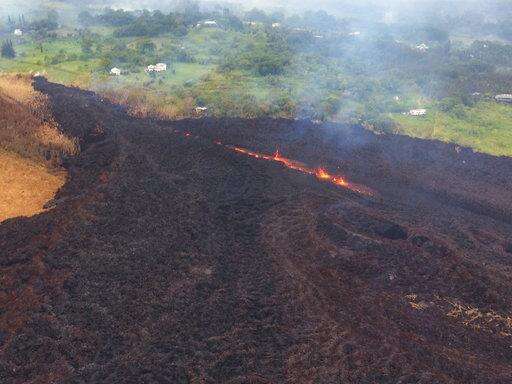
This Thursday, May 17, 2018, aerial image released by the U.S. Geological Survey, shows Fissure 17 at about 07:00 a.m. HST., in Pahoa, Hawaii. The HVO field crew reported that the spattering height and intensity at Fissure 17 seemed to have intensified slightly from yesterday, but the length of active spattering in the fissure is shorter. The overall vigor of Fissure 17 appears to have dropped over the past two days, accompanying a stalling of the Fissure 17 flow front. (U.S. Geological Survey via AP)
The Associated Press
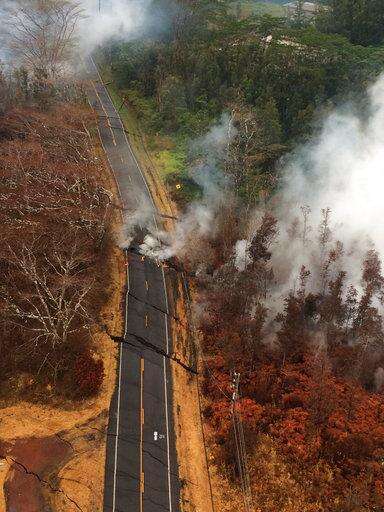
This Thursday, May 17, 2018, aerial image released by the U.S. Geological Survey, shows a view of ground cracks on Pohoiki Road during an overflight of the eruptive fissure area at about 7:00 a.m. HST near Pahoa, Hawaii. Cracks continued to open and widen, some with horizontal and vertical offsets, in the area during the past 24 hours. These cracks are caused by the underlying intrusion of magma into the lower East Rift Zone in the Big Island of Hawaii. (U.S. Geological Survey via AP)
The Associated Press
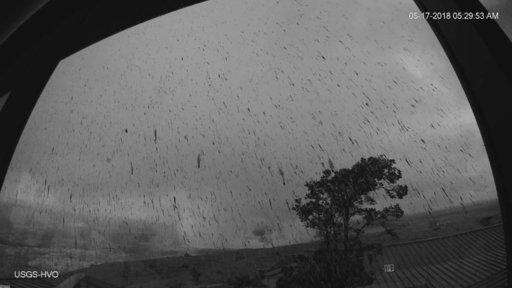
This Thursday, May 17, 2018 image provided by the U.S. Geological Survey shows a view of the ash plume resulting from an early morning explosion at Kilauea Volcano, in Hawaii. The volcano has erupted from its summit, shooting a dusty plume of ash about 30,000 feet into the sky. Mike Poland, a geophysicist with the U.S. Geological Survey, confirmed the explosion on Thursday. It comes after more than a dozen fissures recently opened miles to the east of the crater and spewed lava into neighborhoods. (U.S. Geological Survey/HVO via AP)
The Associated Press
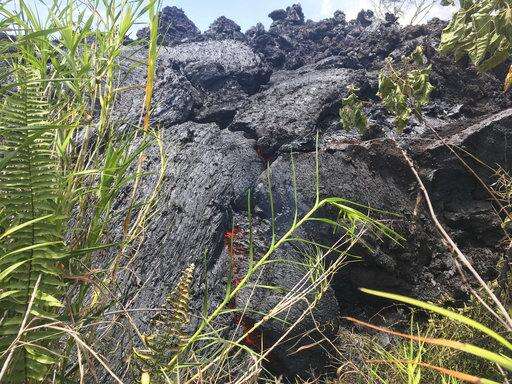
In this Tuesday, May 15, 2018 photo provided by the U.S. Geological Survey, highly viscous lava oozes from the edge of a flow spreading slowly from fissure 17 at Kilauea Volcano, in Hawaii. Earthquakes were damaging roads and buildings on Hawaii's Big Island on Wednesday as ash emissions streamed from Kilauea volcano. Scientists say earthquakes may shake loose rocks underground and open up new tunnels for lava to flow.(U.S. Geological Survey/HVO via AP)
The Associated Press
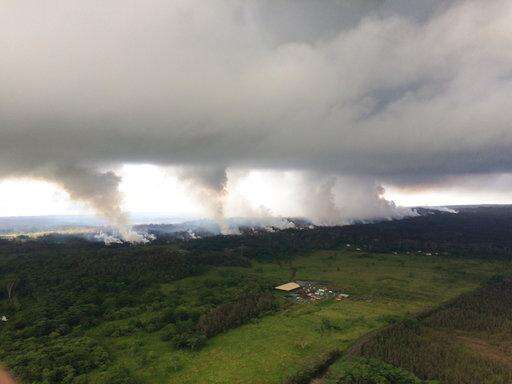
This Wednesday, May 16, 2018, image provided by the U.S. Geological Survey shows sulfur dioxide plumes rising from fissures along the rift and accumulating in the cloud deck, viewed from the Hawaiian Volcano Observatory overflight in the morning at 8:25 a.m., HST near Pahoa, Hawaii. Plumes range from 1 to 2 kilometers (3,000 to 6,000 feet) above the ground. Officials say some vents formed by Kilauea volcano are releasing such high levels of sulfur dioxide that the gas poses an immediate danger to anyone nearby. (U.S. Geological Survey via AP)
The Associated Press
Clouds, ash and volcanic gases hang over Hawaii's Big Island, Thursday, May 17, 2018, after Kilauea volcano erupted from the summit crater earlier in the day. (AP Photo/Caleb Jones)
The Associated Press
Clouds, ash and volcanic gases hang over Hawaii's Big Island, Thursday, May 17, 2018, after Kilauea volcano erupted from the summit crater earlier in the day. (AP Photo/Caleb Jones)
The Associated Press
Cones and signs warn of cracks in the road near the entrance to Hawaii Volcanoes National Park, Thursday, May 17, 2018, near Volcano, Hawaii. (AP Photo/Caleb Jones)
The Associated Press
Lindsey Magnani, center, her finance Elroy Rodrigues, left, and their children, Kahele, right, and Kayden, not shown, pick up respirators to help protect against ash from Kilauea volcano, Thursday, May 17, 2018, in Volcano, Hawaii. Free respirators were being handed out to communities around the volcano after it erupted early Thursday, sending a plume of ash about 30,000 feet into the air. (AP Photo/Caleb Jones)
The Associated Press
A respirator to help protect against ash from Kilauea volcano sits on a desk at a distribution center in Volcano, Hawaii, on Thursday, May 17, 2018. Free respirators were being handed out to communities around the volcano after it erupted early Thursday, sending a plume of ash about 30,000 feet into the air. (AP Photo/Caleb Jones)
The Associated Press